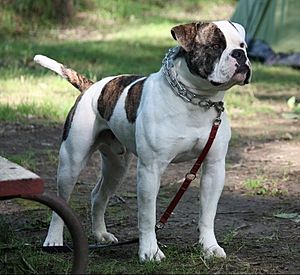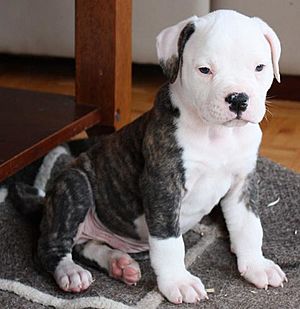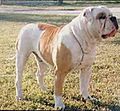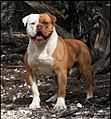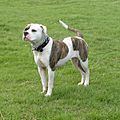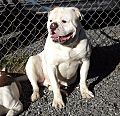American Bulldog facts for kids
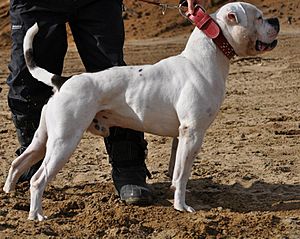
American Bulldog
|
|||||||||||||||||||||||||||||||||
| Other names | Southern White White English Old Southern White Bulldog Hill Bulldog Country Bulldog English White Bulldog |
||||||||||||||||||||||||||||||||
|---|---|---|---|---|---|---|---|---|---|---|---|---|---|---|---|---|---|---|---|---|---|---|---|---|---|---|---|---|---|---|---|---|---|
| Origin | United States | ||||||||||||||||||||||||||||||||
|
|||||||||||||||||||||||||||||||||
| Domestic dog (Canis lupus familiaris) | |||||||||||||||||||||||||||||||||
The American Bulldog is a strong, large dog breed. It came from the Old English Bulldog. Today, these dogs help on farms, compete in dog sports, and are shown in dog shows. They are an important part of American history and culture. Many people see them as a symbol of strength in the United States. In November 2019, the American Bulldog was added to the American Kennel Club (AKC) Foundation Stock Service (FSS).
Contents
History of the American Bulldog
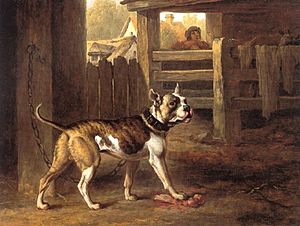
The ancestors of the American Bulldog were Old English Bulldogs. Working people brought these dogs with them to the American South. This happened as early as the 1600s. Small farmers and ranchers used these dogs for many jobs. They were farm guardians, helped with livestock, and caught animals.
Back then, dogs were not grouped into official breeds like today. There were no kennel clubs until 1875. The Old English Bulldogs had different types. Some were for moving cattle, some for farm work, and some for butchers. A sport called bull-baiting was also popular. Even though this sport was banned in the U.K. in 1835, the dogs in America were not affected.
In America, ranchers kept different types of "bulldog" dogs. They chose dogs that were best for working on farms. Later, some dogs became guards on large farms.
One very important job for the American Bulldog was dealing with feral pigs. These pigs were brought to America and had no natural enemies. The bulldogs were the only way settlers could control these animals. This helped the breed survive and grow in the South.
By World War II, the American Bulldog was almost gone. A man named John D. Johnson traveled the South to find the best dogs. He wanted to bring the breed back. A young man named Alan Scott joined Johnson in this effort. Scott later mixed Johnson's dogs with other working bulldogs from Southern farms. This created the Standard type American Bulldog, also called the Scott type. Johnson also crossed his dogs with an old type of English bulldog. This created the Bully type American Bulldog, also known as the Johnson type or Classic type.
Today, American Bulldogs are safe from extinction. They are popular in their home country. People use them as working dogs, protectors, or family pets. Around the world, they help catch escaped pigs or hunt razorbacks. They also help move cattle. American Bulldogs are good at dog sports like dog obedience and weight pulling. They also compete in dog shows held by clubs like the UKC.
What American Bulldogs Look Like
The American Bulldog is a strong, muscular dog. It has a large head and a powerful body. Its shoulders and chest are usually very strong. The dog's coat is short and smooth. It does not need much grooming, just a bath every few weeks. They shed a little bit.
Historically, their coats were mostly white with patches of red, black, or brown. Now, they come in many colors like black, red, brown, and all shades of brindle. Solid black or blue colors are not preferred in dog shows. A black nose and eye rims are usually preferred. Their eyes are often brown, but some have different colored eyes.
American Bulldogs are known to drool more than some other dog breeds. The Bully type is usually bigger and heavier. It has a shorter nose, but it should still be able to breathe easily. The Standard type is more athletic. It has a longer nose and a more square head. Many modern American Bulldogs are a mix of these two types, called "hybrid."
Most American Bulldogs weigh between 27 and 54 kilograms (60 to 120 pounds). They are 52 to 70 centimeters (20 to 28 inches) tall at the shoulder. However, some can be much larger.
American Bulldog Personality
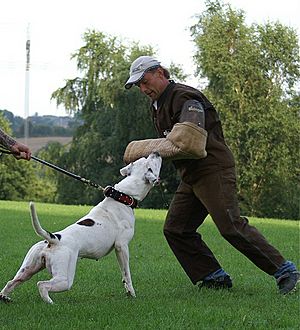
American Bulldogs are usually confident, friendly, and playful dogs. They love being with their families. They form strong bonds with their owners and are happiest when they get lots of attention. They are not always friendly with strangers at first. Their ancestors were farm dogs that guarded the home and animals.
These dogs mature later than many other breeds, around two years old. As puppies, they might be curious but a bit shy with new people. As adults, they become more confident.
It is very important to socialize this breed. This means letting them meet many different people, places, and other dogs. If they are left alone too much, they can become fearful or aggressive towards things they don't know. These are large dogs, so they need to learn about the world outside their home.
American Bulldogs can chew on furniture or shoes if they get bored. This is another reason why being alone too much is bad for them. Things that might make them fearful or aggressive include other dogs, children they don't know, or strangers. An American Bulldog needs to learn from its owner what is a threat and what is not. They need to know when to protect their home and when everything is okay.
With children, it's important to socialize the dog from a young age. True aggression towards babies or young children is rare. This breed usually likes children. If they get to know children well, they are more likely to play with them. They can be very patient with kids who tug on their ears. A well-raised American Bulldog can be playful and devoted to the children in its family.
Owners of this breed should understand that they are powerful and strong-willed. They need to set clear rules and train their dog consistently. They should not be first-time dog owners. Training should be firm but fair. Harsh methods will not work and can make the dog stubborn or angry.
American Bulldogs need a lot of exercise. Owners should have places where the dog can run. However, they should not be off-leash unless the area is safely fenced. A tall fence is a must because they love to explore and might wander off. A microchip is also a good idea in case they get lost. Young American Bulldogs (under three years old) are very bouncy. They might accidentally knock over small children or older adults. So, it's best for adults to handle them on a leash.
Unlike most other bulldog breeds, American Bulldogs can swim well. They don't love water like a retriever, but they can swim if they need to. They can jump over 3 feet high because of their strong muscles. They love to run, jump, and play rough. Games like rugby or Frisbee are perfect for them. They love to be included in games with kids or teenagers.
Supervising an American Bulldog around babies is very important. Dogs need to learn how to behave around babies. An American Bulldog has a history as a guardian dog. They need to learn that a baby is a tiny family member. A well-behaved American Bulldog will be gentle and watchful over a baby. They will patiently let a baby tug on their ears. Any aggressive behavior is not typical for this breed. In early America, these dogs protected children from intruders and wild animals.
American Bulldogs can get along with other dogs in the household if they are introduced properly. It's best to introduce new dogs on neutral ground. They might not be good with strange dogs, especially in busy places like dog parks. The more they are trained and socialized, the better they will be around other dogs and people.
Ongoing training is very important for this breed. Originally, they were bred to be working farm dogs. They could catch wild pigs and cattle, kill pests, and guard property. But with proper training, exercise, and socialization, they can become loyal and playful family pets. They love to play and join family outings.
In the South, they are often both a pet and a hunter. They are brave dogs that can help catch wild pigs. They protect the hunters and other dogs from the pig's tusks. But they also have a soft side. After a hunt, they can easily switch to being a loving family member. They enjoy playing with children and napping on their bed. They are good at catching pigs and can also help with cattle. They will stand their ground against an angry steer. Overall, the American Bulldog truly loves its family. It will do anything to keep them safe, even risking its own life.
American Bulldog Health
American Bulldogs usually live for 10 to 16 years. They are generally strong, active, and healthy dogs. Some health problems are found in certain family lines of American Bulldogs. Other issues are more common in the breed as a whole. These include neuronal ceroid lipofuscinosis (NCL), Ichthyosis, kidney and thyroid problems, ACL tears, hip dysplasia, cherry eye, elbow dysplasia, entropion, ectropion, and bone cancer.
There are DNA tests for NCL and Ichthyosis. These tests help breeders check their dogs before breeding. It's also recommended to screen breeding dogs for hip and elbow problems using tests like Penn Hip or OFA (Orthopedic Foundation for Animals). Some American Bulldogs can also have allergies.
Gallery
See also
 In Spanish: Bulldog americano para niños
In Spanish: Bulldog americano para niños


